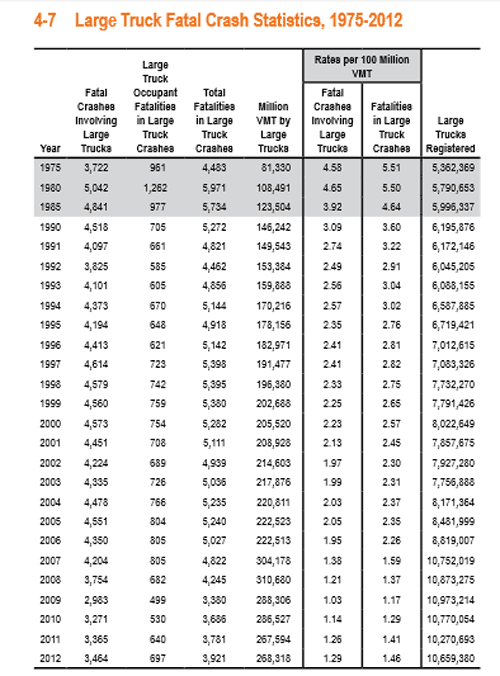From SCDigest's On-Target E-Magazine
- Aug. 5, 2014 -
Supply Chain News: Truck Safety becoming Major News, as High Profile Accidents, Recent Increases Changing Perceptions
After Decade Long Drop, Fatal Truck Accidents Back on the Rise
SCDigest Editorial Staff
The Hours of Service Rules from the US Federal Motor Carrier Safety Administration that went into effect July 1, 2013 were in the news for several years, as the changes were debated, the rules finally mandated after a rather lengthy delay, and then court and legislative actions to pull back some of the new HOS provisions.
SCDigest Says: |
 |
| The 34-hour restart provision is complicated. Advocate say it gives drivers more time for rest. Opponents say it puts more truckers on the road in peak traffic times. |
|
What Do You Say?
|
|
|
|
Most of the initial and on-going push back to the changes revolved around the fact that the new rules weren't needed - trucking safety was improving year over year, so the new rules would have a big impact on trucking productivity with little benefit to public safety, according to the American Trucking Associations and other industry groups.
Typical was this comment from Brenda Neville, president of the Iowa Motor Truck Association, an ATA affiliate, during a 2010 FMCSA listening session on the potential changes: "The truck-involved fatality rate has reached an all-time low under the current hours-of-services rules. These are good rules that allow drivers to gain quality rest."
And as best the industry knew then, that statement was accurate. Accident and fatality rates were steadily decreasing, according to FMCSA statistics, leaving many to wonder if the FMCSA just didn't have it out for truckers regardless of the evidence.
Fatal accidents involving "large trucks" on US highways in fact fell from 4573 in 2000 to just 2983 in 2009, a decrease of some 35%. But as these statistics come out on a couple of year lag to the current year, many may not know that since 2009, the fatality rate is headed the other way.
The fatality rate moved up in each year from 2010 through 2012, the last year for which the FMCSA has data, reaching 3464 deaths in 2012, a jump of 16% over 2009.
The natural reaction might be that the increase over the past few years simply reflects increased trucking activity during the lukewarm recovery that has followed the bottom of the recession in mid-2009. But as the table below shows, that isn't true - the number of trucks on US highways has remained basically flat over that period, and fatal accident per million vehicle miles travelled has jumped from 1.03 in 2009 to 1.29 in 2012.

Source: FMCSA
That equals 9.4 fatal accidents in the US per day involving large trucks, on top of the 100,000 or so injured every year in accidents involving trucks.
This data obviously does not identify the cause of the accidents, and the ATA and others have said in the past that the majority of the accidents were not the fault of the truck driver. Tracking down that information is tough, because it generally involves manually reviewing accident reports to determine the at fault party.
The ATA says that truck driver mistakes are only responsible for 30% of the fatal accidents, while some safety advocates dispute that number.
A recent report from CNBC noted the change in the safety trend, and suggested why the number of deaths has not received more national prominence and calls to action: "What is clear is that, in any other industry, thousands of deaths a year would generate a national outcry. But because trucking deaths are scattered in small numbers across the country, they don't often get covered in the national news."
SCDigest believes it proper to note that there is not a whole lot of public clamor relative to the many more people killed each year in the US in auto accidents not involving trucks.
Two horrific accidents involving trucks did make national news so far this year, clearly raising public profile of the issue.
(Transportation Management Article Continued Below)
|